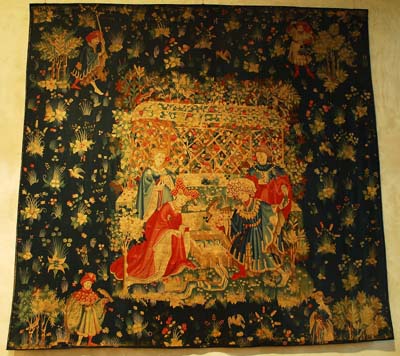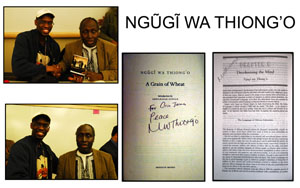1, Januar 2006 - Stefanie Zweig liest von "Nur die Liebe bleibt"

| Stefanie Zweig liest von "Nur die Liebe bleibt" |
Documenting My Life 2013-2011Back to 2014 entries Older entries here 2012-2011 |
1, Januar 2006 - Stefanie Zweig liest von "Nur die Liebe bleibt"
|
November 8, 2013
November 8, 2013 Gerade habe ich diesen Schatz in meine Kollektion gefunden. Im Jahr 2006, als ich in Deutschland war, hatte ich die Gelegenheit Stefanie Zweig, Autorin von "Nirgendwo in Afrika", zu treffen. Bei deisem Treffen, war ich Zuschauer zu ihre Lesung von "Nur die Liebe bleibt". Zum Gluck hatte ich mein Videoapparat dabei und es war mir erlaubt die Lesung aufzunehmen. Nach dieser Lesung stellte ich ihr ein paar Fragen dar (seh Foto). Schau mal den Film an! viel spass dabei! -O. James © Orin James 2013
-O. James
© Orin James 2013

October 16, 2013
It's been practically five months since I last posted here and for good reason. Apart from enjoying the summer and fall weather, I have been keeping myself busy. The list of things may be as long as Tolstoy's "War and Peace". So in short, I moved to my current location, and am quickly adjusting to my new surroundings. My immediate observation - the people here are extremely nice! The same can be said of my current students, who are coming from all parts of the world. Over the past six - eight weeks, I have worked consistantly to maintain a high/rigorous standard for my students, while making learning fun and inviting. In doing so, I added a youtube channel containing videos of myself detailing some important features of the body (see Youtube channel button on bottom left of the menu bar to the left of this frame). About sixty percent of my students are watching these videos and are using them as intended, a secondary source to provide them with the reassurance they may need. Another element I have added is field trips. Our first field trip was to the Buffalo Museum of Science, where we observed an exhibit on cadavers posed in various artistic forms. Sadly, I was only permitted to take six students, leaving, as you may guess, many quite sad and upset. Those who went were kind enough to share their thoughts on the trip right here: Students Blog about Trip Here. That is a group photo of them in the upper right corner. More exciting things I have been doing include, yes, my radio show. I haven't given it up, I will have more on that at a later time along with more photos to share with you. That's all for now. Please check back at a later time for more info on what I am doing.
-O. James 11:22 AM 10/16/2013
© Orin James 2013
June 28, 2013
Wool
South Netherlandish, ca. 1400-1415
The Cloisters Collection, 2011

Falkenlied
I brought up a falcon for more than a year.
When I had him tamed as I wanted
And when I had adorned his feathers with gold,
He hopped up into the sky and flew to another land.
Since then I have seen the falcon flying:
He wore silken jesses on his feet,
And his feathers were all red-gold.
God bring together those who want to love each other!
-Der von Kürenberg
This recently discovered tapestry depicting courtly figures training a falcon is in remarkably good condition. At the center of the tapestry: four luxuriously dressed figures are gathered in front of a rose trellis and flowering turf bench. The lady and the gentleman in the foreground, attended by courtiers behind them, are encouraging the falcon to bathe in the basin of water between them. Four additional figures at the corners, set againt a flowering, or millefleurs ground, are also busy training falcons.
In the Middle Ages, falcons are sometimes depicted tearing hares in pieces. If hares symbolize lasciviousness, as many interpret it, falcons in this case would signify the conquest of love. Generally speaking, however, this is the victory of the solar, bright male principle over the lunar, dark female principle (Penguin Dictionary of Symbols).
June 14, 2013

Story Traditions with James is Back! This summer I am highlighting French literature. Everything from Medieval to early 20th century. The image of the left is from one of the popular unicorn tapestries found in Cloisters museum. For more images with captions click here The Unicorn Tapestries. The tapestries were made in the Southern Netherlands. The story is one of intrigue and fascination. It is often interpreted as a pagan or christian allegory. Pagan interpretations point to the role of the horn on the head of the unicorn, the hunt and the virgin as symbols of lovers, while the same symbols point to the Passion of Christ. A look at these interpretations along with more symbolic gestures of Medieval France/France will be discussed on this summer's Story Traditions with James series. You don't want to miss this. Every Friday 7am -10am. I will also post each episode here on my website. The first episode includes a discussion of Cliges. Intro to French Literature Here
June 7, 2013
| Summer Fun: Graz Alumni Reunion |
Well, as you may all know, we all are equipped with "pleasure centers" or "feel good" regions of the brain that are controlled by neurotransmitters. The simple sight, smell or even thought of something that elicited a past gleeful experience will inevitably evoke a similar experience when seen, smelled or thought of again. This counts for experiences in both the distant as well the immediate past. So, if you want to feel good, no need to use over-the-counter or prescription drugs, only special gleeful memories! My travels abroad and home led me to believe you never leave a place the same, part of it comes with you, while part of you is left behind. Such human-shaping moments have irrevocably led to only wonderful memories that elicit release of my "feel good" neurotransmitters and excitation of my brain's "pleasure centers", when I recall them. Needless to say, while it is good to "feel good" in isolation, it is even better when around those that were there or part of that human-shaping instance. All of us continue to grow, work and master life, but we never forget our experiences abroad. This brings us together more than once a year for more gleeful times. These encounters will always have a place on my calendar!
Before meeting the group, I arrived in NYC in the wee hours of the morning. I spent the early hours touring the Cloisters museum and the Metropolitan Museum of Art before meeting the group. This year we met in NYC's Neue Galerie. Taking photos was prohibited. The exhibition highlighted the works of Kolomon Moser's work. Today he can easily be percieved as Austria's premier interior decorator. After looking at his works on the 3rd floor, we descended to the second floor where we saw the works of Klimmt, kokoschka among notable others. After that we sat down for dinner in the museums restaurant and proceeded to converse until closing time. I found out one of us is a food Connoisseur. Looking to try a new recipe? Check out here blog here: The Twin's Blog
The images in the short film were taken at the Cloisters and The Metropolitan Museum of Art.
June 3, 2013
| Summer Fun: Visiting Washington D.C. |
This summer I indulge in one of my favorite past times, traveling. I decided to stay in the U.S. this summer to save money
and prepare for my big move to the state next door. My first trip was to Washington D.C. I have been here in the past,
but not after the
Dr. Martin Luther King Jr. Memorial was erected. The construction of the African American Museum of History
and Culture also caught my attention. But, I found out it would not be completed before 2015 and its welcome center is closed on Mondays,
a double wammy! Nonetheless, I spent the delightful, orange day, meeting new people,
walking the mall and visiting the various Smithsonian museums. For captioned images of
what I saw. Images of Washington D.C. here.
April 6, 2013

Today at around 4pm I got to meet Ngũgĩ wa Thiong'o. After years of studying some of his works and two years of teaching Decolonising the Mind to freshmen students, I finally got to meet the man of all this thought. He sat behinds another scholar, namely Ali Mazrui and they both payed homage to the late Chinua Achebe, before going into some of their own thoughts on current day Africa. Dr. Thiong'o elucidated his views on the problematic usage of the term tribes when discussing the various African communities. Dr Mazrui then went on to address the various criticisms he has received over the years for his extensive body of work. Although Thiong'o seems to have moved passed Decolonising the Mind into the realm of addressing the role of the scholar, he still took time to share with me his views of the role the Arabic language is playing in various parts of Africa. After all, this is what Decolonising the Mind is all about, the notion that language carries culture. He also took time out to engage in a brief discussion on his text A Grain of Wheat, a text I will be discussing on next week's radio show. What fascinated me the most about Thiong'o was his willingess to talk about some of the texts he wrote over 30 years ago, with both enthusiasm and intellect. Thiong'o continues to inspire me to look at our history and question the causes of particular events. My interests now turn to the Mau Mau and A Grain of Wheat.
My Radio Show Discussing Decolonising the Mind here.
New York State African Studies Association website here.
April 3, 2013
This year's freshman Order and Choas class read and analyzed several import literary texts this term through the lens of several well known theories. At the end of the term students had to provide a brief analysis of the text of their choice using a number of the theories we discussed in class. This video shows, with the help of some friends, one student's, analysis of Leo Tolstoy's The Kreutzer Sonata. For a look at the syllabus of this terms material click here: Order and Chaos SyllabusMarch 25, 2013
| My Nursing Students Visit a Cadaver |
Thanks to caring individuals, who donated their bodies for the benefit of science, this year's nursing students got the wonderful opportunity to learn and appreciate the human body via a cadaver. Our expert tour guide explained the process of procuring these bodies, the impact this has on the families of those who donated their bodies and the mutual understanding and respect that exist between donor, family and student. After explaining this to us, we then proceeded to view various parts of the body, specifically the muscles and bones of the limbs. Once thorougly going over the gross anatomy of these structures, we moved to an open cadaver, where we detailed the various structures of each system. There is no denying that this experience is a must for all individuals going into the health profession, or anyone who will be interacting with individuals on a personal one on one basis, as a thorough understanding of the body will certainly alter how we care and interact with our own and others' bodies. Touching tissues gives one the sense that the tissues can be saved, when damaged. Touching the organs gives one the sense that the organs can be saved when impaired. Touching the whole body, gives one the sense that the body can be saved when weakend. It is this sense that may drive one towards medicine or any health care field. It is this sense that has lead to great great medical discoveries. It is this sense we get from viewing and touching the cadaver...So I personally thank the donors for their contribution to the development of this sense.
More From Students Here-O. James
© Orin James 2013
March 1, 2013 (interview took place in Sept. of 2009)
In honor of Women's History Month, I have posted an interview I conducted with Carol Linskey back in 2009, than a doctoral candidate at Binghamton University, Carol discusses women's internationalism with me, a very important topic, whose relevance cannot be underestimated. Enjoy!February 11-13, 2013
February 1, 2013
Suprisingly enough, many people think that there is no longer the need to celebrate Black History Month. Well, before I put forth my argument for the significance and importance of this month, I will first share with you relevant content that will provide for a lively discussion of this topic. First, to your immediate right is a video of Pan-Africanist, and scholar, Dr. John Henrik Clarke. It is titled A Great and Mighty Walk. Once you have watched this film, tune into my radio series titled Odyssey into Black History (see menu bar on left). At the end of February after paying close attention to the film and my radio show, we will be better able to tackle the question of the importance of Black History Month. So, at the very least, dedicate yourself to becoming informed on the issues that affect African Americans and how they relate to the larger framework of American society...Stay tuned.
January 21, 2013
The following lines from a Cavalcanti poem below illustrates that the heart was perceived as the seat of emotions in the old days:
You have my mind so filled with sorrow That the soul contrives to depart, And the sighs that the sorrowing heart sends forth Show on sight that it cannot bear up, Love, that senses your great power, Says: "It pains me that you must die...
We now know, however, that this is not case, and never has been, but it's still a nice romantic gesture ☺. The heart's primary function is to pump oxygen-rich blood to the rest of the body, and return oxygen-poor blood to the lungs, as my students and I discussed this past week, along with the electrocardiogram (ECG/EKG). Briefly, oxygen rich blood is collected from the lungs via the pulmonary veins (2 right and 2 left). These veins will drain the blood into the left atrium. From the left atrium the oxygen rich blood will drain into left ventricle across the mitral valves. The left atrium will contract and force the remaining blood into the left ventricle. Once the left ventricle is completely filled, it will contract, shut the mitral valve and force the oxygen rich blood into the aorta across the aortic valve. This blood flow circuitry is referrered to as the "systemic circuit". Want to know about the right side? Keep reading... The EKG is used to detect the electrical impulses generated by the heart muscles prior to contraction (see video). Basics on cardiovascular system here.

January 14, 2013
Got sufficient energy? Escaped a dangerous situation lately? Waking up on time? Having mood swings? Finding your voice deepening? Growing hair where you shouldn't? Have you stopped growing? Feeling a tender swelling of your breasts monthly? Voiding liters upon liters of urine? Wanting to cuddle during the winter months? Finding yourself sexually aroused in the wee hours of the morning? How's that sugar level of yours? Why did Barry Bonds' testes suddenly shrink? Where did he find the energy to hit all them home runs? Heard Lance Armstrong's confession? Experienced a broken bone and its repair?...The response to these questions, as to how and why, will involve a discussion of the endocrine system and the hormones therein. This week we looked at the major hormones of the hypothalamus and the pituitary gland along with the microscopic anatomy these structures. Basics on endocrine system here.